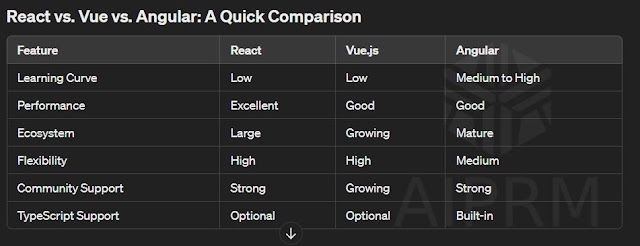Exploring the World of Front-End Frameworks: React vs. Vue vs. Angular
Introduction to Front-End Frameworks
Front-end frameworks play a crucial role in modern web development, providing developers with tools and libraries to build interactive and dynamic user interfaces. Among the most popular front-end frameworks are React, Vue, and Angular. In this comprehensive guide, we'll explore the features, strengths, and use cases of each framework to help you make an informed decision when choosing the right tool for your next project.
Why Front-End Frameworks Matter
Before we dive into the comparison of React, Vue, and Angular, let's discuss why front-end frameworks are essential in web development.
1. Efficiency: Front-end frameworks streamline the development process by providing pre-built components, state management solutions, and routing mechanisms, allowing developers to focus on building features rather than reinventing the wheel.
2. Consistency: Frameworks enforce best practices and coding conventions, ensuring consistency and maintainability across projects and teams.
3. Performance: Many front-end frameworks are optimized for performance, with features like virtual DOM rendering, lazy loading, and code splitting to enhance the user experience.
React: A Declarative Library for Building User Interfaces
React, developed by Facebook, is a declarative and component-based library for building user interfaces. It's known for its simplicity, flexibility, and a large ecosystem of third-party libraries and tools.
Strengths of React
- Component-Based Architecture: React's component-based architecture promotes reusability and modularity, making it easy to build complex UIs from smaller, self-contained components.
- Virtual DOM: React uses a virtual DOM to efficiently update the UI, minimizing the number of DOM manipulations and improving performance.
- React Native: With React Native, developers can use React to build cross-platform mobile applications, sharing code between web and mobile projects.
Vue.js: The Progressive JavaScript Framework
Vue.js is a progressive JavaScript framework for building user interfaces. It's designed to be incrementally adoptable, allowing developers to integrate it into existing projects easily.
Strengths of Vue.js
- Ease of Learning: Vue's gentle learning curve and intuitive API make it accessible to developers of all skill levels, from beginners to experts.
- Flexibility: Vue offers a flexible and modular architecture, allowing developers to pick and choose features based on project requirements.
- Vue CLI: Vue CLI provides a fully-featured build toolchain for Vue projects, including scaffolding, hot module replacement, and production optimization.
Angular: The Full-Featured MVC Framework
Angular, developed by Google, is a full-featured MVC (Model-View-Controller) framework for building large-scale, enterprise-grade web applications. It provides a comprehensive solution for front-end development, including data binding, dependency injection, and routing.
Strengths of Angular
- Comprehensive Solution: Angular provides everything you need to build a modern web application, including a robust component architecture, built-in form validation, and powerful tooling like Angular CLI.
- TypeScript Support: Angular is built with TypeScript, a statically typed superset of JavaScript, which provides enhanced developer productivity, code maintainability, and tooling support.
- RxJS Integration: Angular integrates seamlessly with RxJS, a reactive programming library, allowing developers to manage asynchronous data streams and handle complex asynchronous operations.
Choosing the Right Framework for Your Project
When choosing between React, Vue, and Angular for your project, consider factors such as project requirements, team expertise, and community support. Each framework has its strengths and use cases, so it's essential to evaluate them based on your specific needs.
In conclusion, React, Vue, and Angular are three popular front-end frameworks, each with its own strengths and use cases. Whether you're building a simple UI component or a complex web application, there's a framework that's right for your project. By understanding the features and capabilities of each framework, you can make an informed decision and leverage the power of modern front-end development to build compelling user experiences.


